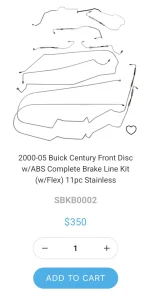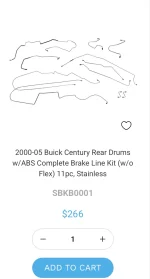ede smith
Member
- Joined
- Apr 8, 2021
- Messages
- 95
- Reaction score
- 11
- Points
- 8
- Buick Ownership
- Century

“They are ‘Bubble’ or ‘ISO’ flares, not a double flare… Despite what the internet tells you, you need a bubble flare tool.” Buick Forums
“My Reatta… uses a flare called an ISO flare. … Do not let the counter People tell You that all that is, is a double flare. It is not and They can NOT be interchanged.” AACA Forums
“Older brake lines require a double flare… But newer GMs (mid‑90s and up) use a bubble flare which is a different flaring tool.”


I was going to do that, but was trying to figure out the correct flare—and then ulcyc's recommendation changed my course. Have you replaced yours with NiCopp and if so which flaring tool did you buy? The Lisle flaring tool I was looking at was $70, the NiCopp roll with some fittings was.$30. A decent 3/16" tubing bender like the Rigid one is $70, although it sounds like that wouldn't be necessary. At $100 that's about 1/2 to 1/3 the price of preformed lines which certainly is a savings, although time should be a factor too as I will be doing this on my back on the concrete driveway.My recommendation is to purchase a 25 foot roll of NiCopp in each tubing size you will need along with the required brake nuts/fittings, and then get one of the loaner brake flare tool kits from Advance/Carquest, O'Reilly or AutoZone, and make your own lines.
NiCopp is much, much easier to work with compared to steel or stainless steel lines, and will last far longer than any steel or stainless steel brake line. Making flares on NiCopp is also much easier! NiCopp is stronger than steel or stainless steel, is DOT approved for brake lines and does not need special tools for making curves or bends in it.
You can order NiCopp online from rockauto.com or amazon for extremely reasonable prices as compared to getting it locally at a brick and mortar parts store.
Yeah I will be working on my back in the driveway. What are your preferred tools for this? I think I left my brake bleeder wrench and am trying to make sure I have everything on hand before beginning!I've done many cars with rolls of brake line and the proper tools on a lift. But for a novice working in his driveway ready fit lines is the way to go. Also will cut the time laying on your back in half. Also getting the correct fittings and unions can be a headache and waiting for the post office to show up.
That sounds like it was a PITA. I'm sure experiences vary as ulycyc had good experience with pre-bent. Yeah the deal with pre-bent lines is as soon as the packing bend is undone, they are no longer returnable. That's what inline tubing told me as I guess they get lots of people with fitment issues that try to return them. I think I am going to go with my original direction and order CU-NI. I will save myself some money and just do one line at time.Just a little story about pre-bent lines, my daughter had a 2000 Impala, same chassis as the Regal, and needing to replace all the brake lines I bought factory bent lines. They were good, mostly, except that the one that went all the way to the right rear was long and very "twisty" and followed a convoluted route through the engine compartment from the anti-lock unit (Installed before drive-train on assembly line).
Be prepared to cut it in half (sort of) in order to wiggle it into place, and then using a flare union reassemble it in place (flare it on the bench, you will be glad you did).
After the expense, and trouble of that adventure, I had OEM, steel brake lines again, but with a union in the one.
Never again have I bought pre-bent lines, they are good for body off restoration jobs, not repairs. For repairs I always use CU-NI which flares easily, bends by hand if you don't have tools, and corrodes at a much slower rate than steel.
We ended up having a large selection of tubing tools here, including European bubble, and inverted double flare, GM used both!
If you wonder what your car has, go to the parts store and ask to look at a caliper, it will be evident when you look at the inlet!
